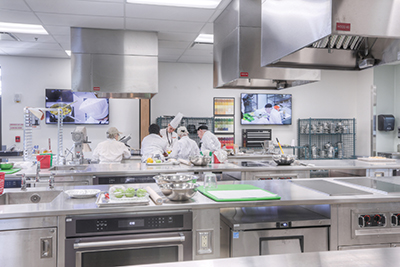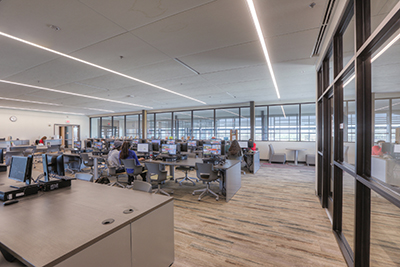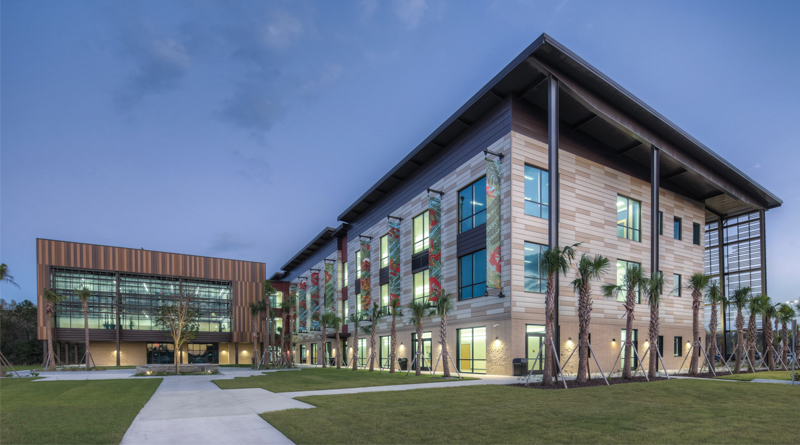Designing a New Student Experience for Higher Education
By Nicole Nichols
Higher education creates opportunities for students to follow their dreams, provide for their families and master skills. Some communities across the country, however, lack access to higher education facilities and programs, forcing residents to make difficult life choices.
In one community southwest of Kissimmee, Fla., thousands of students were without direct access to higher education institutions for many years. Students fought the daily grind of a 90-minute round-trip commute by car; those who relied on the bus for transportation suffered through a two-hour, one-way trip as they pursued degrees or certificates from Valencia College’s West and Osceola campuses. Fortunately, that all changed in the fall of 2017 with the opening of the new Valencia Poinciana Campus.
The realization of a vision that launched 10 years prior, the new campus serves the growing higher education needs of the local community that bridges Osceola and surrounding counties, and provides much needed and desired accessible education to students of the Poinciana community.
“When we started construction on the Poinciana Campus, I was often asked, ‘Why are you building a campus in Poinciana? No one from Poinciana goes to college.’ I would consistently respond, ‘That is precisely why we are building a campus in Poinciana,’” Kathleen Plinske, Ed.D., campus president for Osceola, Lake Nona and Poinciana campuses.
National firm DLR Group was hired to master plan and program the new campus, and to design the first three buildings, which include:
• A 63,894-square-foot, multi-use facility that houses 12 classrooms, a science lab, two computer labs and a culinary teaching kitchen to serve the new Hospitality Program. Additionally, as the first and main building for the campus, this facility includes necessary financial and student services, administration offices, conference rooms, a library, a café and a multipurpose gathering room that opens to a central courtyard that can be used by the college and community for events.
• The 11,706-square-foot Center for Accelerated Training, which houses rotating programs of six- to 12-week certification courses such as basic construction, transportation logistics, advanced manufacturing and fork-lift operating as well as continuing education courses in English as a Second Language and Spanish.
• A 4,220-square-foot Central Utility Plant servicing the entire campus with room for future campus growth.
DLR Group’s planning efforts for this campus stem from its belief that truly successful higher education capital improvements focus on three considerations: student culture, community investment and sustainability.
Designing a Student Campus Culture
Higher education designs are formed from a deep understanding of core institutional programs, services and stakeholders. Designs that are most effective serve the unique needs of the local student body. At Valencia College’s Poinciana Campus, this translates into a campus culture designed to serve thousands of local students, many of whom are the first generation in their family to attend college. Building upon the long history and success of the Valencia College network, this new campus is a fresh start that creates a memorable student experience.

“When you step onto campus you feel a sense of optimism. Students express excitement about the future with deep-rooted emotion, as though they are now physically standing in a vision they have had without knowing if it would ever be their reality,” said Mark Hose, Valencia College facility planner.
A majority of the population served by the Poinciana Campus is Latino, specifically from Puerto Rico. DLR Group’s design celebrates the surrounding community’s heritage and pays homage to the iconic Poinciana (or “flame”) trees, which are common in Puerto Rico and are viewed as symbols of hope. Two Poinciana trees in the student courtyard are the focal point for the campus’ inspiration. The trees’ placement, coupled with a courtyard that opens toward the community, welcomes visitors and creates a sense of pride for the new campus.
Biomimicry of the Poinciana tree is used throughout the exterior and interior design of the main building as inspiration to the community and a reminder of hope and aspiration. DLR Group incorporated the tree’s foliage as the pattern for shading devices on the south side of the building, and colorful banners along the north side celebrate the blooming red flowers. The interior color palette blends warm wood tones reflective of the beautiful Poinciana tree with bold red moments in the cool-toned carpeting, recalling the picturesque tapestry of the ground after the red flowers have fallen. The design also features a student-gathering plaza that inhabits the second and third floors of the north-south portion of the building. This plaza is lovingly termed the “Treehouse” as it sits nestled between the finished, polished Poinciana Trees’ courtyard to its west and the native Floridian conservation forest to its east.
Because the design reflects the local culture, students who attend Poinciana Campus feel at home, while also staying connected to the greater Valencia College student experience. They finally have a designated space where they can learn and socialize with their peers while achieving their higher education goals.
Community-Based Dynamic
The Poinciana Campus is a true community campus, supported both locally and by the state. Leaders within the local community rallied with state officials to create lifelong learning opportunities for residents of all ages.

Photo Credit (all): Macbeth Studio/Courtesy of DLR Group
“The Poinciana Campus is a game-changer for the community,” said Plinske. “Before, a college education was simply out of reach for many students. Now, a college education is available in our students’ backyard.”
The 19-acre site was donated by Osceola County, and the design and construction was funded by the state. The state legislature approved a series of funding for the school, including $1 million in 2014 for planning funds, $11.9 million in 2015 to fund half of the construction costs and an additional $12.1 million in 2016, which helped transform the Poinciana Campus from a dream into reality. Recognizing the critical need for the campus, the Board of Trustees of Valencia College also allocated $2 million from reserves to accelerate the planning and design of the campus.
“We were so fortunate that our local, county and state leadership recognized the tremendous need for the Poinciana Campus and found the resources necessary to make higher education accessible for a community that historically had been underserved,” said Plinske.
To read the entire story, check out the March/April issue of School Construction News.
Nicole Nichols, AIA, is DLR Group’s higher education leader and principal in the national design firm.

